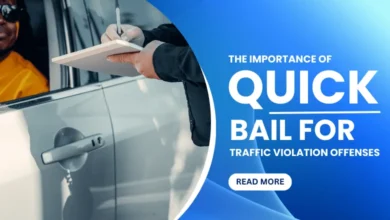5 Prison Visitation Rules You Should Know

Did you know that there are almost 2 million people in prison in the USA? If you are looking to visit someone who is incarcerated this can prove a little difficult and there are a lot of prison visitation rules that you have to follow.
Many penal facilities limit who can visit and when you can visit. You may find there are limitations on what you can bring for the inmate and also limitations on the length of visits.
We have created this guide to prison visitation for you. Read on to find out more about visiting someone in prison.
1. Dress Code for Visitation
One of the important rules when visiting an inmate is the dress code. Visitors need to take into consideration this when planning an outfit. The dress code for prison visitation can vary between correctional facilities, but here are some general guidelines to keep in mind:
Modesty
Dress in a modest manner, avoiding clothing that may be revealing, provocative, or excessively tight-fitting. Avoid low-cut tops, shorts, skirts above knee length, or clothing that exposes midriffs or bare shoulders. Some facilities may require sleeves on shirts or blouses.
Avoid Clothing Resembling Inmate Attire
It’s important not to wear clothing that resembles the attire worn by inmates, such as orange jumpsuits or khaki-colored clothing. This helps to avoid confusion or any potential security concerns.
Non-Offensive Clothing
Refrain from wearing clothing with offensive or inappropriate language, images, or symbols. This includes clothing with profanity, gang-related symbols, or controversial political or religious statements.
Appropriate Footwear
Choose comfortable and appropriate footwear. Avoid wearing open-toed shoes, flip-flops, or high heels, as some facilities may have restrictions on these types of shoes for security reasons. Closed-toe shoes or sneakers are often recommended.
Colors and Patterns
Some prisons have restrictions on certain colors or patterns associated with gang affiliations. It’s advisable to avoid wearing all-white or all-black clothing, as well as clothing with specific colors or patterns that may be prohibited by the facility.
Jewelry and Accessories
Keep jewelry and accessories minimal. Avoid wearing excessive or bulky jewelry, as it may be subject to inspection or could potentially pose a security risk.
It’s advisable to contact the prison directly or check their website for detailed dress code regulations and any additional guidelines they may have in place.
2. Identifying Yourself to the Corrections Officer
When you plan to go for a prison visit, it’s important to conduct an inmate search beforehand to ensure that you’re submitting documents at the correct facility. Remember to bring your photo identification. This is so the corrections office can properly identify you.
In most states, a legal form of photo identification such as a driver’s license or passport is required in order to enter the prison facilities. If you don’t have a valid form of photo identification, most corrections offices will accept another form such as an employment card, school ID, birth certificate, or court order.
Once your identity is established, you may also be required to submit to a background investigation or provide a list of references. If you’re visiting someone from out of state, you may also need to be accompanied by a local resident.
3. Expected Conduct During Visitation
Contact between inmates and visitors is prohibited and strictly enforced. Some prisons may even allow for only verbal interaction between inmates and their guests
Make sure to refrain from any type of disruptive behavior, such as using loud profanity or creating disturbances. It is also important to observe contraband regulations. This means that visitors should never bring in any type of item without prior approval from the prison.
4. Possession Restrictions
It is important to understand the visitation rules that are in place at the prison, particularly with respect to possession restrictions. Here are some common possession restrictions to be aware of:
Prohibited Items
Prisons have a list of prohibited items that visitors are not allowed to bring inside. This list typically includes weapons, drugs, alcohol, tobacco products, lighters, matches, cameras, recording devices, cell phones, and any other items that could pose a security risk or be used inappropriately.
Personal Belongings
Visitors are often required to store personal belongings, such as bags, purses, backpacks, or briefcases, in designated lockers or storage areas before entering the visitation area. It’s important to bring only essential items like identification, money for vending machines, and any required medical supplies.
Money
Some facilities may allow visitors to bring a limited amount of cash to use at vending machines or for other permitted purchases during the visit. The amount of money allowed can vary, so it’s important to check with the specific facility for their policy on visitor cash.
Prescription Medication
A prison visitor who requires prescription medication is typically allowed to bring it into the facility, but there may be specific procedures to follow. This can include providing documentation.
Any of these prohibitions are checked before entering the visitation room. Adhering to these restrictions is crucial for the safety and security of the prison environment.
5. Phone Calls with Inmates
Be aware that inmates may not receive more than two outgoing and incoming calls per day, and all calls are up to 15 minutes in duration. Never give out any personal information about yourself. It may put you at risk for identity theft or other fraudulent activities.
Most prisons have strict policies against curse words, racial slurs, or other offensive language, so it is important to remain respectful. If an inmate requests to continue the conversation after the 15 minutes are up, be aware that this is prohibited and it is best to end the conversation at that point.
Learn the Prison Visitation Rules Today
It’s important to take prison visitation rules seriously. Visitors should read the rules carefully before attending a visit. Knowing the rules can help make visits successful.
For more information on prison visitation rules, please call your local prison.
Did you find this article helpful? Check out the rest of our blogs!
Also read:







